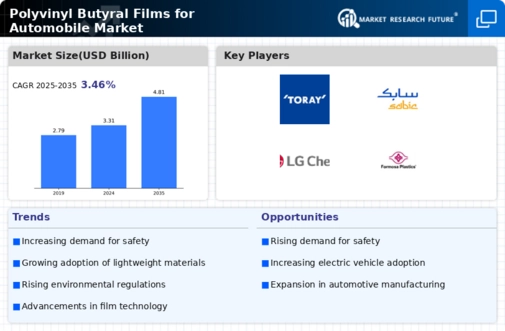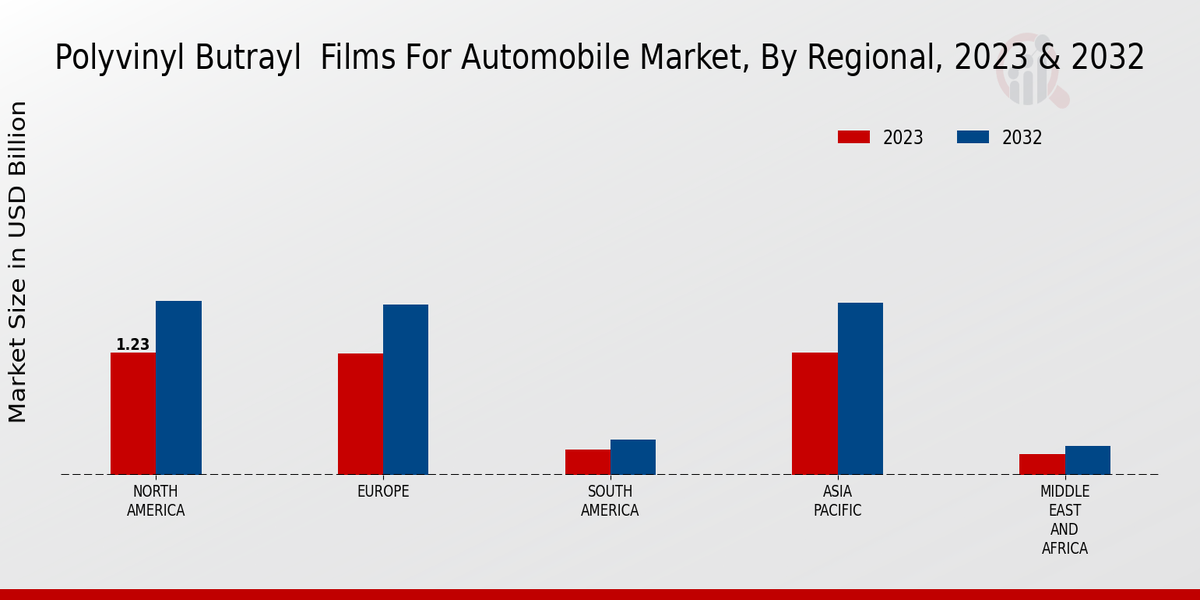Market Growth Projections
The Global Polyvinyl Butyral Films for Automobile Market Industry is projected to experience substantial growth over the next decade. With an estimated market value of 3.31 USD Billion in 2024, the industry is expected to reach 4.81 USD Billion by 2035. This growth trajectory indicates a compound annual growth rate (CAGR) of 3.46% from 2025 to 2035. Such projections reflect the increasing demand for PVB films driven by safety regulations, technological advancements, and changing consumer preferences. The market's expansion is likely to be influenced by various factors, including the rise of electric vehicles and the emphasis on automotive aesthetics.
Growth in Electric Vehicle Production
The Global Polyvinyl Butyral Films for Automobile Market Industry is poised for expansion as the production of electric vehicles (EVs) accelerates. EV manufacturers are increasingly utilizing PVB films in their designs to enhance structural integrity and safety. The shift towards sustainable transportation solutions is likely to drive demand for PVB films, as they contribute to lightweight vehicle construction. With the market anticipated to reach 4.81 USD Billion by 2035, the integration of PVB films in EV production could significantly influence overall market dynamics, reflecting a broader trend towards innovation in the automotive sector.
Regulatory Support for Safety Standards
Regulatory frameworks promoting safety standards in the automotive industry are significantly influencing the Global Polyvinyl Butyral Films for Automobile Market Industry. Governments worldwide are implementing stringent safety regulations that necessitate the use of advanced materials like PVB films in vehicle manufacturing. This regulatory support is likely to bolster market growth as manufacturers seek compliance with safety standards. The increasing focus on consumer safety and environmental sustainability may further drive the adoption of PVB films, positioning the market for continued expansion in the coming years.
Consumer Preferences for Enhanced Aesthetics
Consumer preferences are shifting towards vehicles that not only offer safety but also aesthetic appeal. The Global Polyvinyl Butyral Films for Automobile Market Industry is benefiting from this trend, as PVB films provide superior optical clarity and design flexibility. Automotive manufacturers are increasingly incorporating PVB films to enhance the visual appeal of their vehicles while ensuring safety. This dual focus on aesthetics and functionality is likely to drive demand, contributing to the market's projected growth trajectory. As consumers prioritize both safety and style, the integration of PVB films in automotive design appears to be a strategic move for manufacturers.
Rising Demand for Automotive Safety Features
The Global Polyvinyl Butyral Films for Automobile Market Industry is experiencing a surge in demand driven by the increasing emphasis on automotive safety features. Polyvinyl butyral (PVB) films are integral to laminated safety glass, which enhances vehicle safety by preventing shattering during accidents. As automotive manufacturers prioritize passenger safety, the adoption of PVB films is likely to rise. This trend is reflected in the market's projected growth, with an estimated value of 3.31 USD Billion in 2024, indicating a robust market response to safety regulations and consumer preferences.
Technological Advancements in Film Production
Technological advancements in the production of Polyvinyl Butyral Films for the automobile sector are enhancing the quality and performance of these materials. Innovations in manufacturing processes are likely to improve the durability and optical clarity of PVB films, making them more appealing to automotive manufacturers. As the Global Polyvinyl Butyral Films for Automobile Market Industry evolves, these advancements may lead to increased adoption rates, particularly in high-performance vehicles. The anticipated compound annual growth rate (CAGR) of 3.46% from 2025 to 2035 suggests a sustained interest in these technological improvements, which could reshape market offerings.
















Leave a Comment